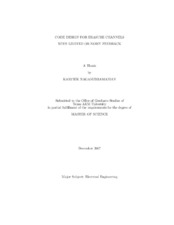| dc.description.abstract | The availability of feedback in communication channels can significantly increase the
reliability of transmission while decreasing the encoding and decoding complexity.
Most of the applications like cellular telephony, satellite communications and internet
involve two-way transmission. Hence, it is important to devise coding schemes which
utilize the advantages of feedback. Most of the results in code designs, which make
use of feedback, concentrate on noiseless and instantaneous feedback. But in real-time
systems, the feedback is usually noisy, and is available at the transmitter after some
delay. Hence, it is important that we characterize the gains obtained in this case over
that of one-way channels.
We consider binary erasure channels to keep the problem tractable. For the erasure channels with noisy feedback, we have designed and analyzed a concatenated
coding scheme, which achieves lower probability of error than any forward error correcting code of the same rate. Hence, it is shown that even noisy feedback can be
useful in increasing the reliability of the channel.
We have designed and analyzed a coding scheme using Low Density Parity Check
(LDPC) codes along with selective retransmission strategy, which utilizes the limited
(but noiseless), delayed feedback to achieve low frame error rates even with small
blocklengths, at rates close to capacity. Furthermore, our scheme provides a way
to trade off feedback bandwidth for reliability. The complexity of this scheme is
lower than that of a forward error correcting code (FEC) of same blocklength and comparable performance.
We have shown that our scheme performs better than the Automatic Repeat
Request (ARQ) protocol which makes use of 1 bit feedback to signal retransmissions.
For fair comparisons, we have also incorporated the rate loss due to the bits which
are fed back in addition to the retransmitted bits. Thus, we have shown that for
two-way communications with complexity and delay constraints, it is better to utilize
the availability of feedback than to use just FEC. | en |


